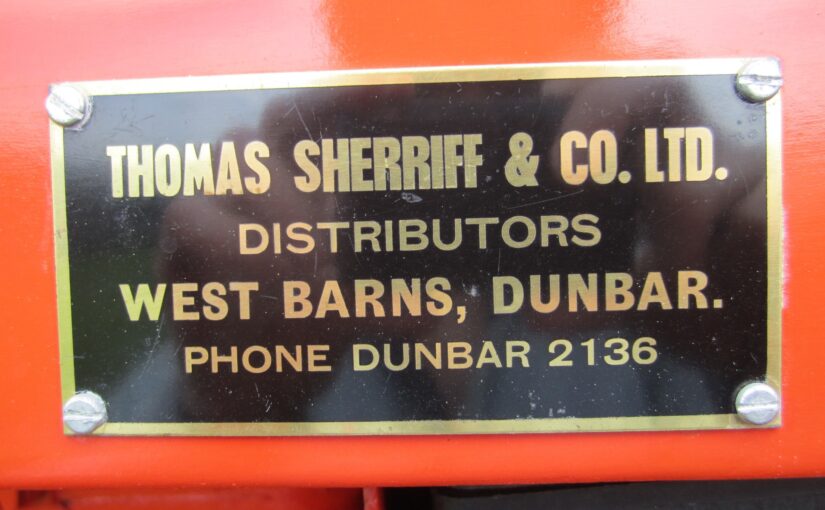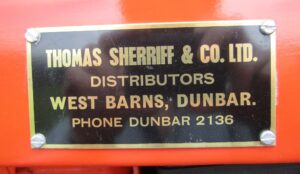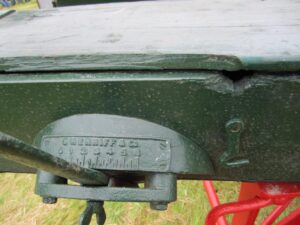East Lothian is well-known as a leading agricultural district. As part of that reputation it has been innovative in the way that it has used the land, grown and harvested crops, raised livestock, as well as developing and using implements and machines to undertake these activities.
The following blog post notes four examples of innovation carried out by different businesses and members of the agricultural community.
Thomas Sherriff
The first is through perhaps the most important implement and machine maker in East Lothian. Although there were only a small number of implement works in the county, the best-known one, was that of Thomas Sherriff. Its location was pinpointed by the North British Agriculturist in 1893: “those who travel to London on the East Coast route, will observe at West Barns, shortly before reaching Dunbar Station, a very neat red brick building, labelled in large letters, “Agricultural Implement Works”.
Thomas Sherriff started his business in 1816. A few months after his unexpected death in December 1856, his widow Agnes Punton, also known as Mrs Thomas Sherriff, took over the business. She ran it until her retiral on 19 July 1871 when she assigned it to Robert Robertson, the works manager, who had started in the works in 1851. On taking it over, the business became known as Thomas Sherriff & Co. He managed it until his death in the mid 1900s. In September 1941 it became a company limited by guarantee, with its main subscriber being Thomas Sherriff Robertson. Although Thomas died in September 1945, the business continued. Today you will recognise the company’s name throughout East Lothian and beyond.
In the nineteenth and early twentieth centuries the business specialised in sowing and cultivating implements and machines. In 1893 its manufactures were described as “drill and broadcast sowing machines”, and later in 1911 as “a varied collection of grain drills, broadcast sowing machines, and turnip and mangold drills”. It also manufactured other “agricultural implements”.
Thomas Sherriff widely exhibited at agricultural shows, including ones in the county and the national one of the Highland and Agricultural Society of Scotland. It entered competitions and trials including those of the aforementioned society and international ones. It was eminently successful at them, winning numerous awards. There were few businesses in Scotland that had received as many. By 1893 it “had taken no fewer than sixty-four medals and prizes at the various shows they have attended”. In March 1887 they were listed as “11 gold medals, 12 silver medals, 8 bronze medals, and 31 money prizes” awarded “in competition with the best makers. For example, in a competition against thirty other makers including “the best English and Scotch” ones at the Dutch International Exhibition in 1872 it won the “first prize gold medal for the best corn and seed drill”. It also won trials, such as one for sowing machines, arranged by the Highland and Agricultural Society of Scotland in 1888 “in competition with twelve other machines”. It was awarded first prize for its sower which then became known as its “first prize broadcast sower”.
Sheriff’s implements and machines were well-known. In 1857 Mrs Thomas Sherriff noted that they “are extensively used in East Lothian by the first farmers”. In April 1863 the business was completing an order “for a set of the most improved machines” that was to be sent to India. In 1893 the agricultural press noted that its sowing machines “are to be found at work in all parts of the world”.
The Sherriff implements and machines had a sound reputation. In 1863 the Illustrated Berwick Journal noted that “the well-known firm of Sherriff, at West Barns, has acquired something more than a local notoriety for the excellence of their manufactures”. By 1899 it had “for many years enjoyed a great reputation for their drills”. Similar comments were made in following years and in 1924 it was described as “a firm with a long-standing reputation as makers of seed-sowing machinery”.
Why did the business have such a reputation? Its manufactures were well-designed, well-made and “of great utility to the farmer”. In 1861 they were “manufactured on the most improved principle”. They were continually improved and included “all the latest improvements for this season”. In 1899 its drills had “been brought up to date by the introduction of improvements suggested by experience”. Even in 1924 they had “a well-established reputation for good workmanship”. Mrs Sherriff had suggested that her manufactures “are the best that can be used”.
As they were practical implements and machines, Sherriff’s concepts and patterns were adopted and used by other makers and came into more wider use. For example, by July 1891 its two-row turnip drill was described as “an implement which has been taken as a type by a large section of the trade”. It was the first maker to bring out the “land-measuring index, attached to sowing machines, by which the quantity of seed per acre can be accurately measured”.
Farmers as implement makers
The second example of how innovation took place in East Lothian is through farmers as implement makers. At least one farmer became an implement maker: David Wilson of East Linton. Through him, the county had a role in the development and manufacture of machines to raise or harvest the potato crop and also to grade or dress it. Many of the leading makers of these machines were in other districts such as Ayrshire and Perthshire.
David Wilson came to East Linton in 1904 from Riccarton Farm, Linlithgow, West Lothian, where he had been a farmer. By 1914 he was recorded at Bridgeside Implement Works. The reason for his coming to East Lothian was recorded by the West Lothian Courier after his death in 1929: “he invented an agricultural implement which caused him to give up farming and leave Linlithgow for East Lothian where he developed a successful business as a result of his genius”.
After he started business in East Lothian he developed, patented and manufactured a number of implements and machines. As an article in The Scotsman in 1922 reported, he had “been responsible for many valuable improvements in the world of agricultural implements”. His first one was a potato dressing machine “of great utility, which promises to bear a part in economising farm labour”. Another early one included “boxes for sprouting seed potatoes” (or chitting boxes) for the first earlies. By 1907 his manufactures included a potato dresser, a patent farmyard manure spreader, a patent thistle and weed cutter, a potato digger and a coup cart. In 1911 he had available for sale “a representative collection” of “potato implements”. He continued to improve the efficiency of his machines. For example, in 1912 he had modified his potato digger so that it could more easily handle the potato shaws or “tops”.
David was ambitious with his implements and machines. He wanted to ensure that they were well-known and had an extensive market. In 1907 he exhibited them at the Royal Agricultural Society of England’s (RASE) show at Lincoln. He was one of a small number of Scottish makers to do so. Three years later, his potato raiser attracted “considerable interest” at that show. He continued to attend in following years. In 1919 he was one of sixteen Scottish exhibitors, and one of eighty one makers that entered in the new implement class. He entered a potato digger or raiser.
David entered a number of machines into the trials of the national agricultural societies in Scotland and England. This included the Highland and Agricultural Society of Scotland’s trials of potato raisers in 1911. It won an equal prize to the other three machines on the ground. In that year he also entered his potato digger and potato sorter into the RASE trials near Spalding. It was reported that “under these conditions it [potato digger] made excellent work, leaving the tubers undamaged, in a nice narrow space, most handy to gather”. By 1918 he advertised that machine with reference to one of these trials. As it notes, the “Highland Society report says:-“less labour in gathering than any other type of machine”. In 1919 he entered a “two row machine for topping and tailing turnips” at the trials of the Highland and Agricultural Society of Scotland.
He was awarded a number of prizes for his implements and machines. They included a “special medal” for a new potato raiser at the East Lothian Show in 1912, and an award of merit for a new potato raiser at the Holland Potato Show at Spalding in 1921.
Farmers as agents
Farmers recognised the importance of particular implements and machines for use on farms in East Lothian. Some of them became agents for particular implements and machines so that they could introduce them and ensure that they were more widely used within the county, and further afield, sometimes for the whole of Scotland. Holding an agency could be prestigious, especially if it was for a national or international business.
In 1886 William Ford, farmer at Fenton Barns, Drem, visited the Colonial and Indian Exhibition in London where he saw the Massey Manufacturing Company’s “Toronto” light binder in the Canadian exhibit. Although it had been used for a number of years in Canada, where there were “several thousands of them” at work, this was the first time it had been exhibited in Britain. Recognising the potential of this lightweight and compact binder, he “ordered a consignment of them” from Toronto. By 1 September that year he had one working on his farm. He arranged and advertised a demonstration of it on his farm working alongside one of the “celebrated binders” of Hornsby of Grantham, a leading English maker. He must have been persuasive for the Massey Manufacturing Co. sent its “expert” to it. The agriculturists who saw the new binder at work were “thoroughly satisfied” with it. In its first season, its use was described as “an unqualified success”.
William was reported to have “introduced the machine into Scotland”. By April 1887 he had become its “agent for Scotland”. He continued to place orders for it, and acted as the Scottish agent until 1889; he continued to sell the machine until 1892. By this time the Massey Co. had set up an office in London. It moved its agency to well-known implement and machine maker in the north-east: G. W. Murray, Banff Foundry, Banff.
William widely promoted the Toronto binder. As noted, he held a public demonstration of it on his farm in September 1886. This was attended by “over fifty prominent agriculturists and other gentlemen”. He also advertised it in the Scottish agricultural press, in the North British Agriculturist from 6 April 1887 until 11 August 1892. He exhibited it at the major agricultural shows that had extensive implement departments. They included those of the agricultural societies of East Lothian, the Highland and Agricultural Society of Scotland, Ayr, Strathearn, Glasgow, and Edinburgh. Show reports commented favourably on it, also noting each year where there had been improvements made.
The binder quickly gained popularity. In July 1887 a report of the Highland and Agricultural Society of Scotland show reported it to be “a feature of great interest, especially to people who have read of its utility on the harvestfield”. By April 1888 it was recorded as “gaining in popularity among Scotch agriculturists”. Two years later, it had “gained quite an unprecedented popularity amongst the class who require binders”.
Steam ploughing
Another use of innovation in East Lothian was the adoption of new technologies by farmers. A key development in nineteenth century agriculture in the county, and throughout Britain, was the application of steam to a range of activities, including ploughing and cultivation, threshing, and pulverising foodstuffs. It was in the application and use of steam to ploughing and cultivation, and the extent to which this was used, that the county was seen as one that was not only “high in agricultural improvement” but also as a “pre-eminent” one in Scotland. This was because the use of steam ploughing and cultivating involved a major investment in terms of capital and expenditure; it also required to be used on large farms, and ones that had large fields and were relatively easy to work.
While the earliest demonstrations of steam ploughing in Scotland were in the mid 1840s, the first one in East Lothian was in 1851. In that year the Marquis of Tweedale had “succeeded in bringing to a great degree of perfection a steam plough”. He tested it out at Yester, his seat in East Lothian, and then used it for a number of years. However, he “abandoned” it owing to its cost.
Although steam ploughing was being used commercially in other counties such as Stirlingshire, Angus and Kincardineshire, in the late 1850s and early 1860s, it was not officially introduced into East Lothian until 1862. This was by Mr Saddler, tenant of Ferrygate, Drem. The introduction on that farm, which was celebrated by a public demonstration and dinner, and attendance by the local MP, was recorded in 71 newspapers across Britain and Ireland. A month later, newspapers reported the introduction of a second steam plough, this time by Mr Begbie, Queenstonbank. By the end of 1863 there were four sets of steam ploughs (of various designs) used on four adjoining farms in the parish of Drem: those at Ferrygate, Queenstonbank, Fentonbarns, and Drem. In 1864 a further neighbour at Castle Mains was reported to have purchased a set. At this time The Scotsman noted that “we do not think that anywhere in the sister country can be witnessed a sight such as that to be seen in East Lothian any time during the present season”. By February 1866, that newspaper commented that “all the various methods of cultivation by steam may be seen within a radius of five or six miles” in the county. By 1875 the North British Agriculturist was able to note that there were “nearly thirty” sets of steam ploughs in the county: “these are mostly hiring sets, and each set will work on an average on a dozen of farms”.
After 1881 when the acreage under crop declined in the county and nationally, so too did the use of steam ploughs. However, in 1903, the Berwickshire News suggested that “steam cultivation is very much in evidence in East Lothian nowadays. No fewer than five steam ploughs are regularly at work in that county at the present time.” However, the North British Agriculturist considered that this number was significant. It reported that: “certainly the enterprise displayed by so many East Lothian agriculturists in equipping their farms with steam-ploughing tackle is rather notable, for probably no other county in Scotland – if not in Great Britain – can show five steam ploughs in regular use on its farms”. Steam ploughing continued to be used in the county until at least the late 1940s. This was at East Barns, Dunbar, by Sir James Hope. He also used continued to use it in Northumberland until as late 1960.
It was the tenant farmers who led the way in introducing this expensive and innovative technology into the county when it became considered to be commercially viable. However, this did not mean that the landowners did not support it. They too were interested in its introduction. They supported it by visiting the public demonstrations of it organised and held by their tenants, and visited them to see their machines at work. In some cases these visits helped them to inform their own decisions on purchase. For example, the Earl of Caithness visited Mr Saddler to see his set at work before purchasing one for his estate at Barrogil in Caithness.




